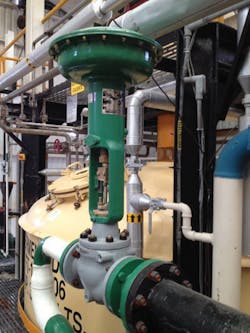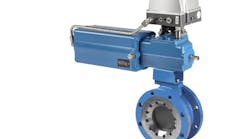This growing trend of using remanufactured equipment has clear benefits. Not only do remanufactured control valves generally cost less and offer short lead-times, but buying remanufactured equipment is also an environmentally conscious decision.
Remanufactured control valves can be produced with such precision and quality that they represent a viable alternative to new equipment. However, automatic control valves are not a “one size fits all.” Accurate sizing and proper specification are essential keys in providing the right size and type of automatic control valve assembly to meet the requirements of the application.
At a minimum, there are two standard tests that must be performed on every control valve. The first is called the Hydrostatic Testing of Control Valves (ANSI/ISA-75.19.01-2013), or a “hydro test.” This test is performed with high pressure water to test the integrity of the valve body assembly, assuring that there aren’t any holes, leaks or cracks in the pressure containment of the valve. This test is critical to the safety performance of the valve.
The second test is known as the Seat Leakage Test, as detailed in Control Valve Seat Leakage Classification and Testing (ANSI/FCI 70-2-2006). This test is performed to make sure that the valve closure section, known as the plug and seat in a sliding-stem globe valve and the ball and seal in a v-notch ball valve, closes off to ensure the required level of tightness.
Different control valve types provide different levels of tightness, or shutoff classification, and each shutoff class has a maximum allowable seat leakage. Shutoff classes are numbered (I, II, III, IV, V and VI), as the allowable leakage rates are found in the standard. In this test, the amount of pressurized air leaking past the plug and seat is measured and compared to standards. If the control valve doesn’t meet these test standards, it must be disassembled, inspected, corrected, and reassembled. It is then retested.
These two tests are done for every control valve in the industry, both original equipment manufacturers (OEM) and remanufactured. There are other, additional tests that can be used to further assure the quality of a remanufactured control valve that also may be unique to the remanufacturer world. These additional tests include Positive Materials Identification, Benchmark Control Valve Diagnostics, Ultrasonic Thickness Testing, and Actuator Spring Testing.
The Positive Materials Identification uses X-Ray fluorescence for metal and alloy analysis of control valve wetted components in order to determine their elemental composition. This test is much more important than many realize, as it can be very difficult to discern the materials of construction of a control valve if it’s unclear exactly what they are. This information is usually on the data plate of the control valve, but in the remanufacturing business these data plates are often illegible, painted over, or missing. Furthermore, OEMs will often describe control valve trim materials as “SST,” referring to stainless steel. But is that 316SST, 416SST, 17-4PH SST, or any number of other stainless steel alloys?
There are many different metals and alloys that could be involved. What needs to be understood is the metal compatibility. This includes compatibility with other metals and compatibility with the process fluids that flow through these control valves. There are thousands of different materials that make up the internal control valve components, so remanufacturers must be 100 percent certain that the right material is selected for the process, and then guarantee that the valve body, trim and packing components are made from this selection.
Another test used by OEMs and some remanufacturers is the Benchmark Control Valve Diagnostics, a trademark product of Black Diamond Engineering, which is recognized and accepted by industry leaders. Benchmark is a series of tests that measure parameters such as valve travel, response time, resolution and friction. These parameters, when combined, can reveal the hysteresis, dead band, and lag (HDL) of the control valve, actuator, and valve positioner. When measured, these different elements are used to determine the performance level of the valve. The test will also tell how well the valve will respond in a process control loop.
Other tests include Ultrasonic Thickness Testing (UT) to help determine proper valve body wall thickness, and Spring Test to confirm or validate the spring rate of worn or unidentified actuator springs.
Proper quality testing is essential in the remanufactured control valve industry. If testing is done incompletely or improperly, systematic failures may occur.
It’s important to deliver peace of mind for those who need to rely on the equipment, and proper, documented testing is the best way to achieve this. With this in mind, are you certain that your repaired, rebuilt and remanufactured valves meet this level of quality and testing?
Jerry Butz, BSEE, CMRP is a process control engineer at Automation Service, a global leader in remanufactured process controls. Mr. Butz has 29 years of hands-on experience in process control and heavy industrial processes, including petrochemical, extrusion/web handling, and bio-fuels. He is a Certified Maintenance & Reliability Professional, as well as a Certified Six Sigma Green Belt. His background includes troubleshooting and root cause failure analysis in addition to sizing and specifying automatic control valves. Jerry can be contacted via email at [email protected].



